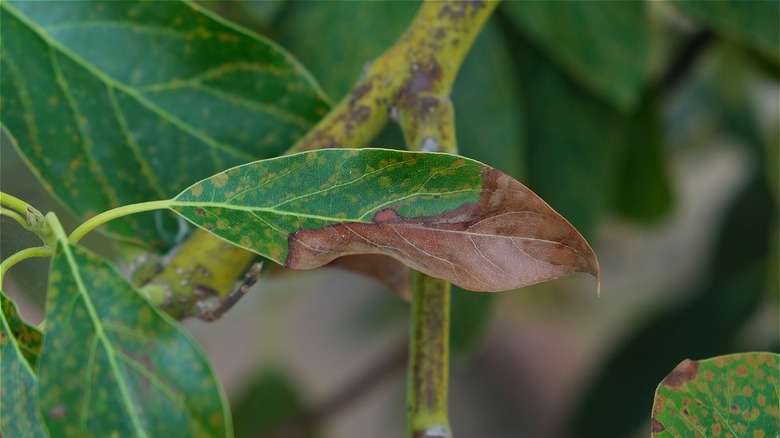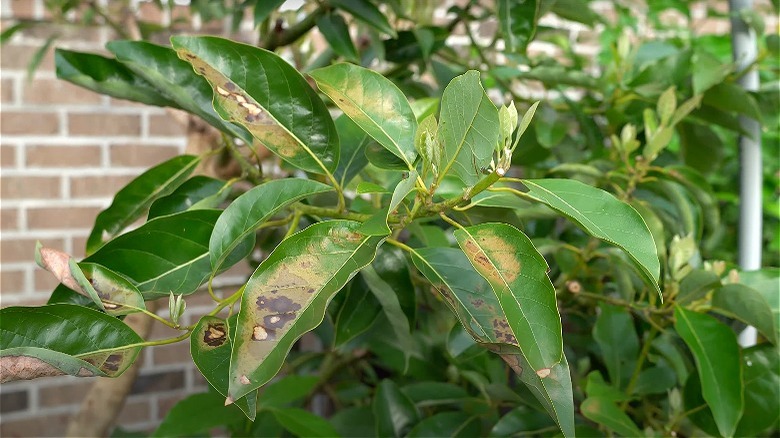Why Your Avocado Tree Leaves Are Turning Brown, And What To Do About It?
Growing avocado trees can be a source of joy if you love looking at green foliage or adore eating guacamole and avocado toast. But the joy can easily turn into concern when the green avocado leaves begin browning. While it's normal for your avocado tree to have 10% of its leaves turn brown at any given time, you must initiate action if the brown spots start taking over your tree entirely. However, making fixes requires the identification of the cause of browning, and for avocado tree leaves, the causes are plenty.
Being tropical evergreen trees, avocados grow better in warm, frost-free zones, but can turn brown when exposed to dry air, which further promotes water loss through excessive transpiration. An overaccumulation of chloride salts in your avocado tree's soil could also possibly turn the leaves brown. Nutrient deficiencies, fungal diseases, and poor pest control are other possible reasons. At times, the leaves may become scorched and wilt away due to excessive heat — a critical issue given the concerns over global warming.
Reasons your avocado tree leaves are turning brown
Oftentimes, avocado leaves carry additional tell-tale signs that help pinpoint the true cause of browning. For instance, if, in addition to becoming brown, the avocado leaves are dry to the touch and wilt quickly, then it could be indicative of underwatering. Checking for dryness in the top 4 inches of the topsoil will help cement your conclusion further.
However, if underwatering isn't an issue, then closely monitoring the pattern of browning can provide further clues. As avocado trees are relatively more sensitive to chlorine salts, any disproportionate buildup due to shallow watering or high evaporation levels can cause the leaves to turn brown from the tips, eventually being taken over in entirety and dying in the process. Getting a salinity test done is another way to verify your prognosis.
Another factor to keep an eye out for is fungal infections and pest infestations. When leaves show small dark brown spots with a yellow halo or circular brownish-black spots that ultimately become sunken, they could indicate Cercospora spot and Anthracnose diseases, respectively. If none of these reasons track, the soil can also be tested for nutritional deficiencies, as poor iron, nitrogen, and zinc levels can possibly lead to brown leaves.
What you can do about it
Not all hope is lost, though. Avocado trees can recover and grow back to their lush green selves once appropriate measures are taken. Dry soils and poor moisture levels can be easily treated through adequate watering down to 2 feet of soil until its texture is spongy. Be careful of overwatering, however, as it may cause the tree to develop root rot. To further improve the soil's porosity, mix 2 inches of compost and reapply it every other month.
If your avocado tree suffers from excessive chloride, flushing out the salts by deep watering twice a week can help, provided the soil is well-drained. Gardeners generally use the leaching fraction, that is, watering an additional 10% to 20% during the cycle. Alternatively, drip sprinklers can be used to water the tree for 24 hours once a month during the hot season.
As for nutritional deficiencies causing the browning of your avocado tree's leaves, suitable fertilizers can be added to the soil based on the soil test results. The treatment for diseases, however, would vary across the types of fungi and pests and might require professional help.


